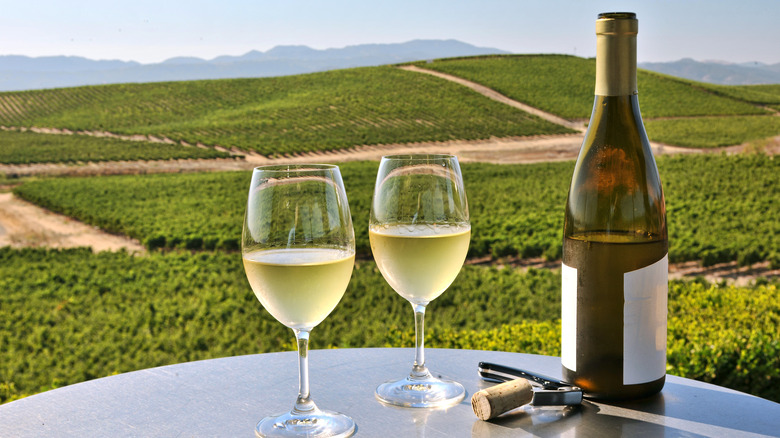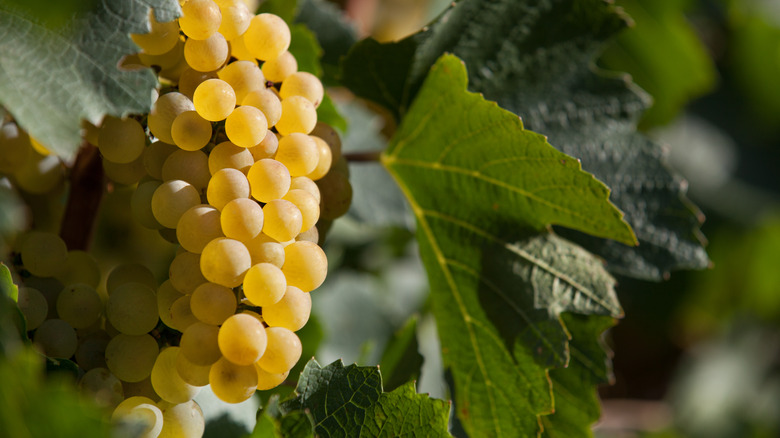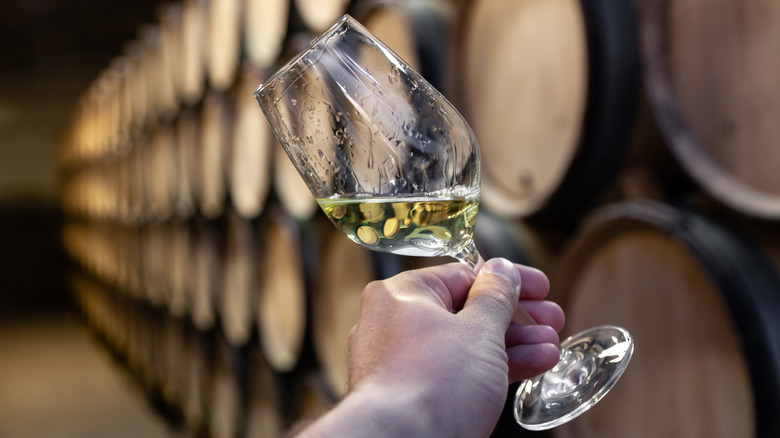What Gives Chardonnay Its Signature Buttery Flavor
Chardonnay is the most frequently consumed white wine varietal worldwide, and its grapes are grown in virtually every wine-producing region around the globe. However, Chardonnay wines are not definable according to a single style or flavor profile since its grapes are extraordinarily versatile and used for plenty of bottles. For example, chardonnay grapes are responsible for the crisp, clean mineral notes of French Chablis, but also for the creamy and buttery white wines made famous by California producers in the 1980s.
There's something that all of these wines have in common, too, and it's a quality that makes them known as "butter bombs" for their rich flavor notes. These wines have typically been aged in oak and have undergone a secondary fermentation process known as malolactic fermentation (MLF). As the name suggests, this process transforms tart malic acid (like that from crisp green apples) into milder and creamier lactic acid. The latter is the same acid found in dairy, so the roots of the buttery flavors begin here. But MLF is also responsible for the production of flavor and aroma compounds like diacetyl, acetaldehyde, and ethyl lactate, which likewise contribute to the buttery characteristics of Chardonnay grapes.
Aging in new oak barrels, typically during the time when MLF takes place, also introduces distinctive flavor notes like vanilla and toast, and softens the texture or mouthfeel of the wine.
The scientific process that gives Chardonnay its flavor
When wine undergoes its primary fermentation process, yeast turns the sugars found naturally in grapes into alcohol and carbon dioxide. Afterward, however, there are many options available to winemakers that will affect the flavor and aroma profile of the finished product, like whether or not to use oak or to allow the malolactic fermentation to proceed. Chardonnay without oak barrels or the MLF process, for example, maintains its fruit-driven character and tends to be crisp and citrusy rather than buttery and creamy.
Winemakers that choose to let their wines undergo MLF must first decide whether they want this to happen during the oak aging or after (MLF can also occur in the same stainless steel tanks hosting the primary fermentation). It's important to note that MLF is not exclusive to Chardonnay. Virtually every red wine undergoes this secondary fermentation step, and it's often used for other white wine grapes as well (notably, Viognier).
The primary fermentation step in wine is initiated by yeast. MLF, by contrast, can happen naturally or through the introduction of a specific bacteria. For Chardonnay, the bacteria of choice is often Oenococcus oeni, which is responsible for creating specific flavor compounds that contribute to buttery flavors and aromas. The process of MLF typically occurs in Chardonnay over about two weeks, although this also depends on several factors (it happens more rapidly in oak barrels than tanks).
The best food pairings for buttery Chardonnay
Not everyone is a fan of buttery Chardonnays, which is why the style has gone in and out of fashion in recent years. But for those who do enjoy them, these smooth and cream wines are an excellent pairing partner for several food dishes. Lobster is perhaps the best-known, but oaked and buttery Chardonnays are also a perfect complement to crab legs, as well as seafood side dish options like corn on the cob and macaroni and cheese.
This style of Chardonnay is also a go-to pairing option for chicken or turkey. Yes, they're a natural with butter chicken, but they go well with roasted chicken, lemon chicken, and even chicken salad — virtually every chicken dish, in fact, including chicken Kiev and tandoori chicken.
Of course, if you're just sitting around the house, you might also like them with a bowl of popcorn. It turns out that one of the primary flavor compounds created during malolactic fermentation is diacetyl. It's so intensely buttery that it has been used as an artificial flavor in microwave popcorn. Thus, having buttery Chardonnay alongside this movie-watching treat is a natural pairing.



